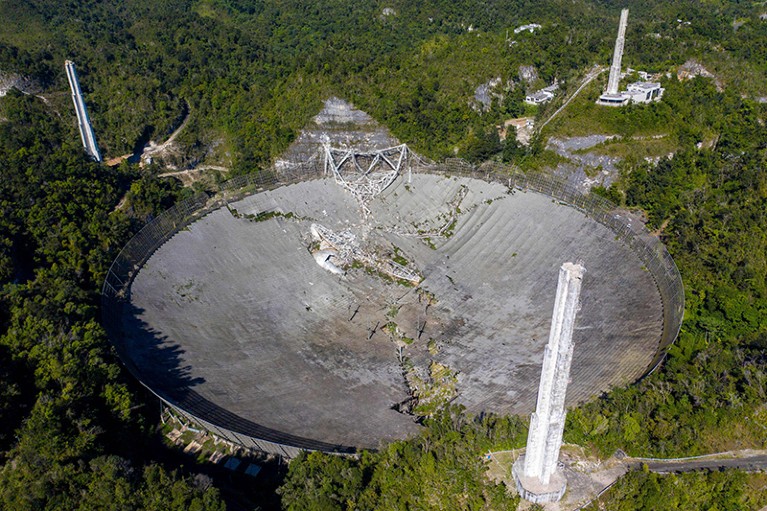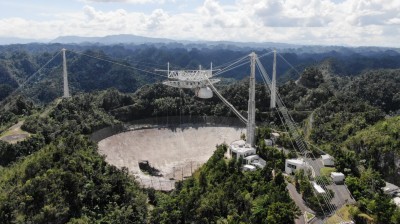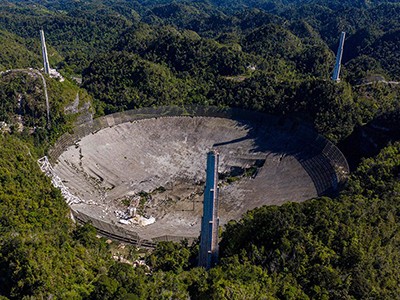
The Arecibo Observatory’s 305-metre-wide telescope dish was destroyed in late 2020, after supporting cables snapped.Credit: Ricardo Arduengo/AFP via Getty
After a world-famous radio telescope at Arecibo Observatory in Puerto Rico collapsed two years ago, many scientists hoped that the US National Science Foundation (NSF), which runs the facility, would eventually build a new one to replace it. Instead, the agency has announced that it will establish an educational centre for science, technology, engineering and maths (STEM) at the site. The revised plan might ramp down or dramatically alter the remaining research being done at Arecibo.
“It’s heartbreaking,” says Héctor Arce, an astronomer at Yale University in New Haven, Connecticut, who is from Puerto Rico and has worked on Arecibo advocacy efforts. “To many it seems like yet another unjust way of treating the colonial territory of Puerto Rico.”
Legendary Arecibo telescope will close forever — scientists are reeling
The NSF says that it is following community recommendations in not planning to rebuild the large telescope and instead establishing the new educational centre. “We are not closing Arecibo,” says Sean Jones, head of the NSF’s directorate of mathematical and physical sciences. “We think this new approach and new centre will be catalytic in many areas.”
The agency announced its plans in a call for proposals on 13 October. It requests ideas for setting up and running an educational centre at Arecibo, at a cost of US$1 million to $3 million per year over five years starting in 2023. That money might or might not include funds to operate research facilities at Arecibo still in use, such as a 12-metre radio antenna and a lidar system that uses lasers to study Earth’s atmosphere.
The situation “could be worse,” says Abel Méndez, a planetary astronomer at the University of Puerto Rico at Arecibo who uses the 12-metre antenna for research and teaching. But “it could be much, much better”.
“It is devastating to know that that’s their ultimate decision,” says Desirée Cotto-Figueroa, an astronomer at the University of Puerto Rico at Humacao. “Especially despite all the efforts made by the staff and scientists of the Arecibo Observatory and by the general scientific community to keep it working as the research centre of excellence that it has always been with the observing facilities that are left.”
A powerhouse of education
One major question is how the Arecibo site will draw students and teachers if there is little active research to participate in. “Yet the NSF calls for proposals for a world-class educational institution,” says Anne Virkki, a planetary scientist at the University of Helsinki in Finland. “How does anyone do that without the world-class scientists, engineers, and instruments?”
The NSF says that it is asking for precisely those sorts of ideas. The new centre could support ongoing work in astronomy and planetary science, or it could focus on other areas such as the biological sciences, says James L. Moore III, the head of the NSF’s education and human resources directorate. “Here’s an opportunity to reimagine what the possibilities could be,” he says.
Gut-wrenching footage documents Arecibo telescope’s collapse
Arecibo Observatory has long been a powerhouse of STEM education in Puerto Rico because of its renowned telescope and place in astronomical history. Students trained there have gone on to become professional astronomers and planetary scientists in many countries.
The 305-metre-wide radio telescope that collapsed in 2020 played a key role in many scientific fields for more than half a century, including the search for extraterrestrial life, the discovery of the first extrasolar planets and of gravitational waves, and the study of near-Earth asteroids and of fast radio bursts.
The NSF has run the observatory since the 1970s, working with a series of contractors. It has been trying to wind down investment at Arecibo since 2006, to shift funding to newer astronomical facilities. Advocates rallied and research continued, but the observatory faced fresh challenges in 2017, when Hurricane Maria damaged much of the facility, and in early 2020 when a series of earthquakes caused more damage.
Then came the collapse of the 305-metre dish. One of its crucial supporting cables failed in August 2020, then another in November of that year, and the NSF decided it was too structurally unsound to repair. An engineering investigation revealed five factors that contributed to the collapse, including the design of the cable system, deferred maintenance, and damage from hurricanes and earthquakes.
An observatory no more
Research has continued at the smaller facilities at Arecibo Observatory. Currently funded projects using those facilities will be able to finish up, Jones says, and scientists can propose to continue their use under the scope of the new educational centre.
Arecibo Observatory: another great lost in 2020
The lidar facilities include a potassium laser that studies the temperature of layers in Earth’s atmosphere, and a planned new instrument to probe aerosols such as atmospheric dust. The 12-metre antenna serves as a node in a long-distance astronomical network operated by European astronomers. Other research projects that use it include Méndez’s studies of red dwarf stars and the habitability of planets around them.
Many who work with Arecibo instruments are now scrambling to figure out how to ramp down their research projects. Under the new plan, the site will no longer be called Arecibo Observatory — becoming instead the Arecibo Center for STEM Education and Research.



